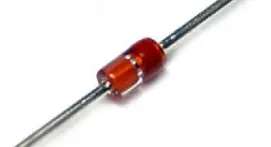Pin diode is a type of diode that has p-type and n-type semiconductor material sandwiching an intrinsic layer. The intrinsic layer is a layer of undoped semiconductor material. This is the structural difference between a normal PN junction diode and a PIN junction diode. Like PN junction diode, ‘P’ refers to the positive p-type region, ‘N’ refers to the negative n-type region and ‘I’ refers to the intrinsic region in the PIN diode.

PIN diode symbol
The symbol of a PIN diode is shown in figure 2. In this figure, A represents anode and K represents cathode.

The basic structure of a PIN diode is shown in figure 3.

A PIN diode is an improvised version of the PN junction diode. Unlike a normal diode, a PIN diode has three layers as mentioned above as shown in figure 3. The use of the intrinsic layer makes the diode highly resistive and helps to induce a large electric field in between the P and N regions of the diode. Due to the presence of a large electric field in the diode, the movement of electrons in the diode increases from N-region to P-region, and hence makes a better diode than the PN junction diode.
The fast movement of electrons makes electron-hole pairs in a fast way and this increases the PIN diode more active towards the signals. The distance between the N-type and P-type regions is more in PIN junction diode than a normal PN junction diode. Hence the capacitance of the PIN diode decreases which makes faster responses towards the signals.
PIN diode working
The presence of the intrinsic layer differs from the working of the PIN diode from that of the PN junction diode. In forward bias condition, when the P-type and the N-type region is connected to the positive and the negative terminals of the supply respectively, the width of the depletion region decreases. The PIN diode works as a variable resistance. This makes the diode works faster as the movement of charges increases from P-type to N-type region.
In reverse biased condition, the width of the depletion region gets increased. In this condition, the PIN diode acts as a capacitor. The width of the intrinsic region increases in such a way that it swept away all the charge carriers of the region. The voltage required to remove all the charge carriers is known as swept voltage. Swept voltage is the reverse-biased voltage applied to the diode.
PIN diode characteristics
The characteristics of the PIN diode include
1. The PIN diode acts as a variable resistor in the forward-biased condition. In that case, the value of resistance of the diode depends on the value of the forward-biased voltage applied to it.
2. The PIN diode acts as a capacitor in the reverse-biased condition where the P-type and the N-type regions act as the positive and negative plates of the capacitor respectively and the intrinsic region behaves as the insulation in between the plates.
3. The PIN diode requires a higher breakdown voltage to breakdown or to destroy the thick depletion of the region.
4. The PIN diode has a sensitivity to radiation. When the radiation falls on the surface of the depletion region, it generates energy.
5. The depletion region stores charge carriers that are responsible for the flow of current.
6. There is no rectification present in the diode as the diode has a variable resistance that depends on the applied voltage.
7. At small frequency signals, the PIN diode gets switched off following the diode equation of small frequency signals. But in the case of higher frequency signals, the diode never gets switched off as the removal of all the charges from the intrinsic region is not possible.
8. The reverse recovery time required for the PIN diode is less.
PIN diode applications
The field of application of the PIN diode is wide. Some of these applications are given below.
1. A PIN diode can be used as a high voltage rectifier as it is capable of bearing higher voltage. It is possible due to the presence of the intrinsic layer.
2. In the case of photodetectors, PIN diodes can be used. The intrinsic region increases the site for the absorption of energy from light. Hence it is used as a photodiode.
3. Due to the decreased capacitance of the diode, it can be used as a switch. The PIN diode can operate at radiofrequency.
4. The PIN diodes are used in the detection of photons in X-rays and gamma rays.
5. Photovoltaic cell uses PIN diodes in their fiber-optic networks.
6. The PIN diodes are also used in microwave switches because of their low capacitance value.
7. The use of the PIN diode is found in the limiter circuit and RF modulator circuit.
Author
Sunmoni Gohain
NIT Silchar
